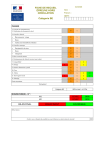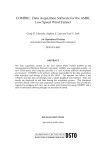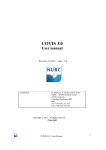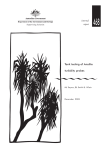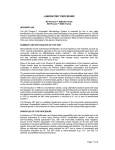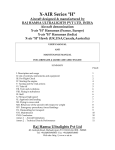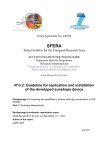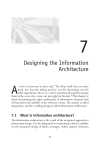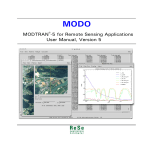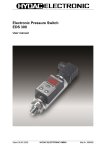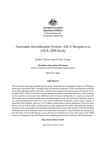Download The Operation of a Three Wavelength Nephelometer and some
Transcript
The Operation of a Three Wavelength Nephelometer and some Measurements Made at Jabiru during 2002 S. B. Carr and M. A. Burridge Intelligence, Surveillance and Reconnaissance Division Information Sciences Laboratory DSTO-TN-0594 ABSTRACT The operation of a three wavelength integrating nephelometer is explained and summarised. This instrument was purchased by ISRD for studies of atmospheric aerosols which play an important role in the propagation of electro-magnetic radiation from the UV through to the mid wave IR. Preliminary results are also reported on the aerosol scattering coefficient measurements made during the months of September through Novemebr 2002 at Jabiru in Kakadu National Park. This data will form the intial part of a long term aerosol monitoring program in the region to be conducted jointly by DSTO and CSIRO. The instrument has been re-installed at Jabiru from about mid September 2004 on an ongoing basis to enable data to be collected on the seasonal variation in aerosol properties. Details on the instrument's performance on an aircraft during experiments conducted during 2003 will be presented in separate reports . RELEASE LIMITATION Approved for public release Published by DSTO Information Sciences Laboratory PO Box 1500 Edinburgh South Australia 5111 Australia Telephone: (08) 8259 5555 Fax: (08) 8259 6567 © Commonwealth of Australia 2004 AR-013-268 November 2004 APPROVED FOR PUBLIC RELEASE The Operation of a Three Wavelength Nephelometer and Some Measurements Made at Jabiru during 2002 Executive Summary The principle aim of task LRR 01/205, part of which is outlined in this report, is to improve DSTO’s knowledge and understanding of the atmospheric aerosol in the top end of the Northern Territory. An aerosol is a suspension of finely divided matter (liquid or solid) dispersed in a gaseous medium such as air. It primarily impacts on sensors sensitive to radiation with wavelengths in the UV (10 nanometres) through to the mid wave IR (5000 nanometres) range, through scattering of radiation causing degradation in the signal received at the sensor. To measure the optical properties of the atmospheric aerosol DSTO has acquired a three wavelength integrating nephelometer from TSI (model 3563). This instrument measures the scattering coefficient of the aerosol at three visible wavelengths denoted here as blue, green and red. The extinction (absorption + scattering) coefficient is the basic quantity that is used to predict the amount of transmission loss in the atmosphere due to both molecular and particulate absorption and scattering. The outcome of the activity reported on here forms a small part of the overall R&D output of the task, which is dominated by the aircraft measurements of the atmospheric aerosol obtained during experiments conducted in 2003. These aircraft measurements were undertaken in the Northern Australian dry season around the region of Jabiru in Kakadu National Park. This work will be reported on separately. The major outcomes of the work reported on here are the obtaining of data on the diurnal properties of the aerosol scattering coefficient over a three-month period at Jabiru and knowledge on the longterm performance of the nephelometer. The instrument was installed in a laboratory located at ERISS [11] field station opposite Jabiru airport. A suitable stack was identified as being ideal to allow access to external air whilst providing shelter for the instrument itself. The instrument was installed and sampling lines were used to both collect the aerosol, transport it to the instrument and to exhaust the sample of air after the measurement was complete. Data was logged to an in-situ PC via a standard serial connection. Proprietary TSI software was used to interface with and control the nephelometer. To interface with the in-situ PC a dial-up network connection was made from a laptop located at Edinburgh. The remote desktop software that comes inbuilt with the windows XP operating system was used to run the software located on the in-situ PC. Data was also transferred back to DSTO on a daily basis and backed-up immediately. All aspects of this activity are unclassified including most notably the data collected. Nonetheless a permission to operate was obtained through the appropriate authorities covering the time the dial-up connection was in use. These results will form part of the larger study being undertaken for task LRR 01/205 Atmospheric Aerosol Research. The main outcome of this task will be to obtain knowledge on regional aerosol properties and hence improve DSTO’s ability to apply models of the atmosphere accurately to the prediction of the performance of electrooptic and infrared sensors. The atmosphere is one part of the total picture, which must also include accurate knowledge on the effect background; targets and the sensor architecture itself have on the performance of these types of sensors in our region and beyond. Further results from the task will be reported on separately including the detailed airborne studies conducted in 2003. The implications of all these measurements on the use of atmospheric models such as MODTRAN will also be covered in a separate report. Contents 1. INTRODUCTION ............................................................................................................... 1 2. THE INSTRUMENT ........................................................................................................... 1 2.1 Calibration and Maintenance ................................................................................. 5 3. LOCATION AND SET-UP ................................................................................................ 7 4. NEPHELOMETER DATA................................................................................................ 10 5. CONCLUSIONS AND FUTURE WORK...................................................................... 14 6. ACKNOWLEDGEMENTS............................................................................................... 16 7. REFERENCES..................................................................................................................... 17 DSTO-TN-0594 1. Introduction As part of the research activities being conducted under the umbrella of the long-range research task LRR 01/205 Atmospheric Aerosol research, DSTO in collaboration with CSIRO’s Earth Observation Centre (EOC) placed a three wavelength integrating nephelometer (neph) at a site in Jabiru located inside Kakadu National Park. The instrument was operated from the 3rd of September to the 20th of November 2002 covering the intense part of the dry season, which is dominated by biomass burning, and, in the latter stages, heading into the beginning of the wet season (the build up). The aim of this activity was to collect data on the variation in the aerosol scattering coefficient over an approximate three-month period. It was also an opportunity to assess the long term operating performance of the instrument. CSIRO have a number of instruments in the field at Jabiru and other sites in Australia. They have an ongoing research program characterising aerosol optical depth on a seasonal basis as part of the AERONET global aerosol-monitoring program. Some of the agencies involved in this global measurement program include NASA and the National Oceanic and Atmospheric Administration (NOAA) from the US. DSTO will be able to leverage this knowledge in exchange for the nephelometer data which in turn can be used by CSIRO to test assumptions about how accurately ground-based measurements are at predicting the aerosol extinction throughout the entire atmospheric column. This will also be of benefit to DSTO as a complement to the aircraft measurements and it is hoped that in combination a useful methodology will be developed to make continued use of ground based measurements to monitor longterm seasonal trends in aerosols in the boundary layer. This will be achieved by reinstalling the nephelometer at Jabiru on a long-term basis. The purpose of this report is to set the context for the ongoing aerosol measurements work being undertaken in DSTO’s Intelligence, Surveillance and Reconnaissance Division (ISRD). The operation of the nephelometer is outlined and preliminary results from the Jabiru deployment are presented. Future reports will cover the aircraft measurements campaign conducted in June and September 2003 [1,2] and ongoing ground-based aerosol measurements at Jabiru that commenced in mid 2004 in collaboration with CSIRO. 2. The Instrument A nephelometer [3] is an instrument designed to calculate the atmospheric aerosol scattering coefficient. Two types of nephelometers are available; integrating and polar. As the name suggests the integrating nephelometer covers all scattering angles giving a total scattering coefficient. The polar nephelometer measures the scattered radiation in 1 DSTO-TN-0594 a specific direction defined by a scattering angle θ . Note this is a two dimensional scattering plane defined by the incoming and outgoing (scattered) rays. DSTO owns and runs a TSI Inc. model 3563 [4] three wavelength integrating nephelometer. This instrument is designed for both ground-based and airborne measurements [5] and is capable of being run autonomously for long-term aerosol sampling. Figure 1: The nephelometer with and without the external cover. The lamp is clearly visible in the first image as is the external blower and lamp fan (two black objects) in the RH image. The instrument is essentially an aluminium scattering chamber that is lined with light absorbing flock paper to minimise scattering off the walls of the chamber. The aerosol is drawn into the scattering chamber via the inlet port that has a valve enabling direct air sampling or filtered air sampling. The filtered air option is used to measure the Rayleigh scattering of molecules and is used to measure the background scattering signal of the instrument due to wall scattering. During ordinary sampling the instrument can become contaminated if the air is very polluted. Therefore it is necessary to periodically measure the background signal to ensure that the most accurate aerosol scattering coefficient is available to the user. The air is drawn into the instrument using an external blower capable of delivering a variable flow depending on the diameter and length of sampling line used and any restriction on the outlet of the neph. A lamp provides illumination via a light pipe and cosine diffuser. A backscatter shutter can be engaged if the backscatter signal is desired. The scattered light passes through a series of apertures and the reference chopper and then a lens 2 DSTO-TN-0594 before being split via colour filters into blue (B), green (G) and red (R) wavelengths, which are then detected by photo multiplier tubes (PMT) located at one end of the instrument. At the other end of the instrument there is a light trap. Figure 2: A schematic of the nephelometer showing the basic layout of the instrument and the location of major components. The reference chopper is a circular plate that makes a full rotation 23 times per second providing the instrument with measurements of the lamp signal, PMT dark current and direct scattering signal. Approximately half of the disc is open allowing the true scattered light to pass through, about a quarter is opaque allowing transmission of the light source alone and the other quarter is dark allowing measurement of the noise signal of the PMT. The backscatter shutter is located between the light source and the apertures when it is engaged and then is rotated out of the way when the total scattering signal is desired. The restricted internal geometry of the neph means that the angular integration is truncated to between 7 and 170 degrees. This becomes particularly important when forward scattering is expected to be important. Methods have been developed to make corrections for the angular truncation of the neph and also to correct for the slight non-Lambertian nature of the light source [6]. A Temperature (T), pressure (P) and a relative humidity (RH) sensor are also fitted to the neph. Heating of the air can occur inside the instrument due to the lamp and through the sampling line. This generally ensures that the temperature inside the neph scattering chamber is higher than ambient, avoiding condensation. A heater is provided to ensure that under all operating conditions sample temperature can be maintained higher than the inlet temperature. The instrument has an onboard signal processing capability with both calibration constants and background wall scatter values stored in internal memory. Communication with the instrument is via a computer running proprietary TSI software either Nephwin or Nephlog. Alternatively data can be retrieved using a terminal interface via a serial port. No special hardware is necessary to run the 3 DSTO-TN-0594 instrument. A single RS 232 serial port is all that is required. The instrument can be run in two modes, polled or unpolled. In unpolled mode the neph outputs data to a computer at predetermined intervals. This provides for very accurate timing signals. However in unpolled mode communication with the instrument is stopped and can only be resumed via the execution of a terminal command under the Nephwin software or via the serial data port. In polled mode the instrument takes all of its timing information from the logging computer and will output data at intervals set by the user under the software. This provides the user with maximum control over the instrument enabling alterations to be made to system parameters. The basic functions of the instrument can be automated by placing the instrument in auto mode. In this case the instrument will perform a zero baseline measurement (ZBM) (background measurement) automatically according to the user-programmed setting. Once this background measurement is complete the instrument will update its internal settings and then revert back to measurement mode after purging the scattering chamber. Purging of the scattering chamber is done before and after a background measurement is made and is another timing parameter that is set by the user. In manual mode the instrument will only enter a ZBM when instructed to by the user via the software. Otherwise the instrument will remain in measurement mode continuously. In auto mode the time it takes the instrument to complete a measurement, perform a ZBM and purge the chamber twice is referred to as the auto-zero period. Typically sampling or averaging times are set between 1 and 5 minutes, the ZBM is 5 minutes and the purge time varies depending on the flow rate of the instrument. As a general rule passing about seven volumes of purged air through the scattering chamber is desired. In reasonably clean air the auto-zero period is typically set to about 1 hour. In very clean air often multiple ZBM are performed over longer time intervals and an average taken. In very polluted air more frequent ZBM may be necessary. The methodology for operating on the ground and on an aircraft is very different. On the ground the user will typically use the auto mode for long-term unattended monitoring of the atmospheric aerosol. The situation on an aircraft being a lot more dynamic and generally of much shorter duration requires more flexibility as to when ZBM measurements are performed and hence manual mode is preferred. In this case the user determines when a ZBM is to be performed. In manual mode the averaging time can be changed more easily with out causing a temporal misalignment between the measurement, zeroing and purging modes, which are now engaged by the user manually. The raw output of the instrument is photon counts, which are then scaled and corrected for time delays in the output of the PMT and the period of the reference chopper. As mentioned earlier the reference chopper enables measurements of both lamp and PMT dark current signals along with the measured signal. It is the measurement of all these other signals that allows the neph to operate at high 4 DSTO-TN-0594 sensitivity measuring scattering coefficients two orders of magnitude better than other nephelometers available on the market. The scaled and corrected photon count output is then passed through a smoothing filter. This smoothing filter is a running boxcar average that depends on the averaging time set by the user. For sampling times less than 5 minutes the boxcar average is 1 second. Using calibration constants and frequent measurements of the background scattering signal from the wall of the instrument the neph then converts the smoothed scaled and corrected photon counts to scattering coefficients which are then passed to the logging computer. Other data that is passed to the computer includes the neph status, raw photon counts, reference chopper revolutions and inlet T, sample T, sample RH and P. If the backscatter shutter mode is invoked the backscatter scattering coefficients are also output. Any zero background measurement carried out during the operation of the neph will also be logged. For more detail on the nephelometer operation refer to the user manual [7]. For details about nephelometer methodology and the performance of the instrument the papers by Anderson and Ogren are excellent [6,8]. The user is cautioned against applying results from other 3563 nephelometers to their own as each instrument will have slightly different operating characteristics and hence noise performance and sensitivity limits should be assessed on an instrument-by-instrument basis. 2.1 Calibration and Maintenance The instrument requires calibration taking into account changes in the performance of the PMT, lamp, any degradation in the colour filters and or reference chopper and contamination of the scattering chamber. Calibration is typically undertaken using two span gases CO2 and filtered ambient air. Ideally the filtered air low span gas should always be at the same temperature and RH so the use of a controlled air source may be preferred. Industrial grade 99.9% pure CO2 is used to provide the most accurate high span gas scattering coefficients. The calibration procedure is outlined in the user manual and under the Nephwin software where there is a calibration menu option with a checklist of the procedures to be followed. Depending on the blower power setting the neph should initially be purged with filtered air for approximately 7 minutes. This is a slightly conservative figure and assumes a very low flow rate of 5 litres per minute (lpm) but will guarantee that the instrument is purged of any remaining particle laden air. Following the purging of the instrument, filtered air measurements should follow for at least 300 seconds to obtain a measured value for the Rayleigh scattering coefficients of air (the Nephwin software displays photon counts during the calibration only). These values should then be stored in the neph. The external cover then needs to be removed to allow access to the small blue filter, which should be detached from the inlet. The neph main inlet port and the outlet should then be plugged. CO2 should then be fed into the secondary inlet connection at a rate of 5 lpm and should be felt exiting the blue filter in the opposite direction to the arrow on the filter. This end of the filter should be connected to a 5 DSTO-TN-0594 sampling line and the CO2 exhausted outside for safety reasons. Again the neph should be purged for 7 minutes and then a 300 second CO2 measurement should commence. The results of the CO2 measurement should then be stored in the neph. The displayed calibration constants should then be assessed for accuracy by comparison with values referred to in the user manual and the previously stored values. If the user is satisfied with these constants they should be saved along with a calibration string identifying the time, date, span gases used and the individual who undertook the calibration. The instrument should then be purged of CO2 and a ZBM performed so the instrument is then ready for measurements again. A calibration should be performed as necessary. In the case of long-term continuous aerosol sampling this should be done routinely with the maintenance schedule. At a minimum the lamp needs to be replaced after about every three to six months if operated at 75 watts. Other nephelometer lamps have lasted six months at 75 watts when left to run continuously [9]. The lamp current should be monitored regularly and if the lamp starts to draw a large current then it should be replaced. This should be done before the lamp stops working to avoid any potential damage to the onboard circuitry of the instrument. Typically the lamp draws about 6 amps when operating at 75 watts. If the current rises above 7 amps the lamp should be replaced. At this time the instrument should be cleaned and the components checked and then a calibration should be performed. Currently, the manufacturer provides no expected lifetime of the PMT but their performance should be monitored and if dark current levels become unacceptably high they should be replaced. The colour filters should be examined for any cloudiness, which is an indication of deterioration of the coating on them due to high moisture levels (which should be avoided if possible). Again depending on the level of cloudiness these filters may need to be replaced. The reference chopper, light pipe lens, and back scatter shutter should be cleaned using a soft lint free cloth and in the case of the light pipe lens and the opaque section of the reference chopper they should be cleaned with a small amount of isopropyl alcohol. Under no circumstances should isopropyl alcohol come into contact with any of the black surfaces. Other groups suggest against cleaning these components unless absolutely necessary [10]. To clean these components of the instrument the scattering chamber will need to be taken apart. The procedures for doing this and for maintenance of the components mentioned above are contained in the user manual. Clean compressed air should be used to clean the flock paper and remove any dirt or debris from within the scattering chamber including the light trap. The temperature, pressure and humidity sensors should be monitored for accuracy and replaced if they malfunction or become too inaccurate. The High Efficiency Particulate Air (HEPA) filter used to provide the filtered air measurement should be checked for blockages if there is a significant increase in the pressure drop across the filter. Otherwise it should be replaced every six months. The small blue DQ filter used to provide filtered airflow to the light pipe lens should be replaced every 12 months. 6 DSTO-TN-0594 3. Location and Set-up To protect the instrument from environmental impact it was decided that it should be installed inside one of the laboratories located at the ERISS [11] field station in Jabiru. A suitable stack was identified as being ideal for allowing access to outside air. Due to the strict requirements of isokinetic sampling it was decided to mount the nephelometer inlet directly under the stack so that a length of straight tubing could be used to transport the aerosol to the instrument. Approximately 3 metres of 22.2 mm I.D. stainless steel (ss) tube was used to transport the aerosol. Stainless steel was chosen for its robustness and excellent sampling characteristics. The inlet end of the tube was chamfered on the outside to a knife-edge providing a sharp edged inlet. We are not interested in size selective sampling so this is the best that can be done to accommodate the variable wind speed and directions encountered. A more sophisticated sampling arrangement could be used that would involve drawing a huge volume of air through the larger external stack (of the order of 1000 lpm) with the smaller nephelometer tube sampling from this airflow within the stack. This is the optimal arrangement however it is beyond the current financial and infrastructure restrictions that DSTO is currently operating under. The blower was set to operate at a 5% power setting producing a flow rate of approximately 20 lpm. This is a relatively high flow rate and hence we can expect some particle losses at the inlet of the ss tube as we are sampling from still air. Wind speed and direction being variable will also affect sampling performance. The mismatch in air speed and direction outside and inside the sampling line violate strict isokinetic sampling conditions. This is most likely to impact on particle sizes above 5 µm and certainly above 10 µm since the larger diameter particles cannot follow the streamlines if the airflow is convoluted. Estimates for aspiration and transport losses [12] can be made using theoretically and empirically determined equations such as found in the aerosol calculator program written by Paul Barron [13]. Transport losses are expected to be small since a length of straight uniform diameter ss tube was used so there are no gravitational settling losses or deposition losses due to the absence of bends and constrictions. The tube Reynolds number is in a region that indicates the flow can become turbulent depending on the initial conditions. We feel that based on the measurements of the flow rate (stable) we made in the laboratory and the results obtained for the measured scattering coefficient the flow was not likely to be turbulent. Even so estimates for turbulent inertial deposition losses can be made using the aerosol calculator program (similarly for other transport losses). Diffusion losses are expected to be small since the relatively high flow rate means the sample does not have a very long residence time in the sampling line. The same justification applies for diffusiophoretic losses. Electrostatic losses are eliminated by using a grounded conductive transport tube and thermophoretic losses are mitigated against since the ss tube is housed inside a stack which is most likely at a higher temperature than outside 7 DSTO-TN-0594 air and the section in the laboratory is insulated using black insulating rubber. Thermophoretic losses are difficult to estimate in a sampling line due to the difficulty in measuring the required temperature gradients. There may be some small losses at the ss tube neph interface. The ss tube slides inside an adaptor, which is threaded into the inlet port (two grub screws in the adaptor hold the ss tube in place) and butts up against a horizontal bar installed by the manufacturer presumably to prevent large debris from entering the scattering chamber and to prevent the sampling line from blocking the filtered air inlet. For this report no attempt has been made to make corrections for aspiration and transport losses or to correct for the effects of the angular truncation of the neph and the slight non-ambertian nature of the light source. The major source of particle loss is expected to be at the inlet of the ss tube. This analysis should be done for future measurements and if this data is to be used in further studies. The other end of the ss tube was covered with a wired mesh dome to protect the inlet from insects and debris. This was then placed under a rain hat that had a wire fence around it sealing the inlet off from larger pests such as birds and rodents. The inlet was mounted above the roof and the ss tube then passed down though the stack into the laboratory to the instrument. The lower part of the stack was then sealed around the ss tube. Exhausting the aerosol from the neph is much less of an issue as strict sampling requirements are not necessary. Three quarter inch plastic tubing was used connecting the neph outlet to an exhaust port mounted on an aluminium plate that was fitted to the window in the laboratory. In this way the inside of the laboratory was completely sealed off from the outside and the neph was able to continuously sample outside air whilst remaining secure and protected inside the lab. 8 DSTO-TN-0594 Figure 3: Left hand image shows the rain hat with wire fence and wire mesh dome visible. The stainless steel tubing is barely visible protruding above the white section of the mesh dome. The ss tube descends into the lab, contained inside the larger stack, where it couples to the neph. The right hand image shows the ss tube protruding below the lower half of the stack inside the lab. It is covered with black rubber to provide thermal insulation from laboratory temperature variation. The plastic tube couples the neph outlet to the exhaust port mounted in the aluminium plate situated in the window. Figure 4: The plastic tube couples to the exhaust port in the window (LHS). The RH image shows an external view of the aluminium plate mounted in the window with another wire mesh dome covering the outside of the exhaust port to prevent contamination. The upper port was for external wires for the unused portable weather station. 9 DSTO-TN-0594 To neph was operated via software installed on a stand-alone computer. This computer was also used to log data. The computer was connected to the neph via a standard RS 232 serial connection. All control of the neph was possible via this software except for the turning on and off of the instrument power supply. To interface with the instrument a standalone laptop was used at DSTO Edinburgh via a dial-up network connection using the remote desktop software that comes in built with the Windows XP operating system. This connection was sufficient to allow a user to control the neph via the software located on the in-situ computer and to download data files on a daily basis back to the laptop located at DSTO. The laptop located at DSTO was an unclassified standalone machine as was the in-situ PC. The use of the dialup connection over that three-month period was consistent with DSTO and Defence security standing orders. All the data collected and the operation of the neph is unclassified. Even so a permission to operate was sought and obtained for the period of operation of the dialup connection. 4. Nephelometer Data The nephelometer logs scattering coefficients for blue, green and red wavelengths according to the averaging time set by the user. Averaging times can range between 1 second and typically 5 minutes depending on how clean the air being sampled is. For these initial measurements the neph was operated in total scatter mode only. The magnitude of the observed scattering coefficients was large and hence it was decided to set the averaging time to 1 minute allowing the instrument to respond to any rapid temporal changes in the aerosol. Whilst it is useful to have this data it is too much to present. To simplify the data presentation hourly averages were calculated and displayed as weekly temporal charts of the scattering coefficient. This is still a great amount of data so further averaging was done to calculate weekly averages and monthly averages. The monthly average will be of most value when multiple years’ worth of data has been collected to enable any changes in the seasonal properties of the aerosol to be observed. For the limited deployment of approximately 3 months the weekly average provides enough of a summary to show the major trend in the aerosol over that period. For select weeks we have also chosen to display the hourly average charts to highlight how the aerosol varies diurnally mainly due to RH effects and then across days and weeks due to local fires. 10 DSTO-TN-0594 Weekly Means - 2002 3.00E-04 Scattering Coefficient m-1 2.50E-04 Blue Green Red 2.00E-04 1.50E-04 1.00E-04 5.00E-05 0.00E+00 3-6 Sep 7-13 Sep 14-20 Sep 21-27 Sep 28Sep- 5-11 Oct 4Oct 12-18 Oct 19-25 Oct 26Oct1Nov 2-8 Nov 9-15 Nov 16-20 Nov Week Figure 5: This chart shows the weekly means covering the period of the sensor deployment. It can be misleading in that although the site at Jabiru was exposed to larger levels of biomass smoke in October resulting in the larger scattering coefficients there was in fact no more biomass burning occurring over the top end as a whole in October as can be seen by examining the fire maps (Fig. 5). 11 DSTO-TN-0594 Hourly Means 3.00E-04 Scattering Coefficient m-1 2.50E-04 Blue 2.00E-04 Green Red 1.50E-04 1.00E-04 5.00E-05 0.00E+00 9/21/2002 9/21/2002 9/22/2002 9/22/2002 9/23/2002 9/23/2002 9/24/2002 9/24/2002 9/25/2002 9/25/2002 9/26/2002 9/26/2002 9/27/2002 9/27/2002 9/28/2002 0:00 12:00 0:00 12:00 0:00 12:00 0:00 12:00 0:00 12:00 0:00 12:00 0:00 12:00 0:00 Day Hourly Means 2.50E-03 2.25E-03 2.00E-03 Scattering Coefficient m-1 1.75E-03 Blue Green 1.50E-03 Red 1.25E-03 1.00E-03 7.50E-04 5.00E-04 2.50E-04 0.00E+00 10/19/02 0:00 10/19/02 10/20/02 12:00 0:00 10/20/02 10/21/02 12:00 0:00 10/21/02 10/22/02 12:00 0:00 10/22/02 10/23/02 12:00 0:00 10/23/02 10/24/02 12:00 0:00 10/24/02 10/25/02 12:00 0:00 10/25/02 10/26/02 12:00 0:00 Day Figure 6: Hourly average temporal traces of the scattering coefficient over a week in September and the last week of October. The gaps in the data are due to power outages beyond the approximately 1 hour lifetime of the UPS backup. The reliability of the power supply is an issue that has been identified for the future as critical. This would not only avoid large gaps in the data but 12 DSTO-TN-0594 also would allow a much more straightforward analysis of the raw data to extract initially hourly averages. Having the higher order temporal data is useful but in future the averaging time of the neph shall be set to 5 minutes to limit the amount of collected data. This will be sufficient to enable the major temporal trends in the atmospheric aerosol in and around Jabiru to be observed whilst keeping the data to manageable levels Figure 7: Sentinel fire spot maps showing the total number of observed events during the weeks under consideration. The top map is for the period 21-28 September and the bottom map is for the 19-26 October. The white dot locates Jabiru. Examining the sentinel fire spot data [14] for these two weeks we see that there is a greater spread of fires in the region East of Jabiru across the Arnhem Land Plateau in September. The most likely explanation for the increased scattering coefficient in 13 DSTO-TN-0594 October is that the prevailing winds over night were from the North exposing the site at Jabiru to the smoke from the large cluster of fires just North of Jabiru. In September with similar weather patterns the absence of fires in this region results in smaller measured scattering coefficients. Furthermore the increase in RH over night results in hydroscopic growth of the smaller smoke particles bringing them into a size range where their impact on light scattering is much greater. Historical met data support this with wind roses from Jabiru airport between 1978 and 2002 indicating that from 6pm through to about 12 am winds are predominately Northerly in October. The combination of the RH increase and wind direction overnight plus the location of the cluster of fires to the North of Jabiru in October is the most likely explanation for the large increase in scattering coefficients. This highlights the need to carefully articulate the prevailing weather conditions and burn conditions in the region for the period during which measurements are being undertaken. Quite obviously prevailing weather conditions, particularly wind direction, are likely to be more or less the same year after year. The exception may be during unique weather events such as an El Nino event. However the location, number and intensity of fires may change year to year in the same region for the same month. Long term monitoring taking into account the quasi randomness of fires is necessary to gain a long term appreciation of the ongoing effects of biomass burning on the aerosol in the region and hence ultimately on the scattering of light. We can also conclude that in all likelihood September’s and November’s results are more representative of typical scattering coefficients across the Arnhem land plateau as most of the smoke being measured in these months will have emanated from fires East of Jabiru in Arnhem land (Fig 5). The winds are predominantly from the East in the daytime. Smoke levels as a general rule during these latter months of the dry season are very high and form a constant haze layer. October’s results tend to reflect the potential (in this case realised) impact of specific local fires on measurements due to, as was discussed, a combination of fire numbers, fire locations and weather conditions. 5. Conclusions and Future Work The nephelometer was seen to operate reliably and continuously without any problems. The issue of unreliable power was beyond the control of DSTO and attempts were made to mitigate this by using a UPS capable of providing approximately 1 hour of backup power. After returning the instrument to DSTO it was taken apart to be cleaned and was found to be in good condition with no major signs of deterioration. There was some 14 DSTO-TN-0594 indication that the colour filters were starting to deteriorate particularly the red filter with a slight cloudy appearance around the edges. This initial installation proved successful in that we have demonstrated that one can sample reliably without exposing the instrument to the environment and without contaminating the ambient air with debris, insects and birds. The initial results highlight the need to have good ground truth about prevailing weather conditions and good information about the number and location of fires. Future data analysis should include comparison with column-integrated measurements such as those obtained with a sun photometer. This would enable us to ascertain how well knowledge about the ground level aerosol scattering coefficient can help to explain the aerosol extinction throughout the entire atmospheric column. The accuracy of the data will depend on how significant the sampling losses were and to a lesser extent the angular truncation effect of the instrument itself. The use of a thin-walled inlet is common practice since this produces the least disturbed airflow at the entrance of the inlet. As mentioned there exists theoretically and empirically determined expressions for losses at the entrance of a thin walled inlet under still air and low airflow sampling conditions. Additional analysis of the meteorological data should be undertaken to determine what the average wind speed and direction was during periods of the deployment so that these values can be used as input to the theoretical expressions. The transport time was relatively short such that effects of aerosol agglomeration or break-up for larger particles would be insignificant. Since RH affects the aerosol scattering coefficient, future measurements should attempt to measure the aerosol at close to ambient RH or at a fixed RH by controlling the temperature of the stainless steel sampling line. For year long sampling the preference is to measure the scattering coefficient at a low RH <40% (dry scattering coefficient) to avoid high levels of humid moist air entering the nephelometer, which can ultimately increase and add to the deterioration of the coatings on the colour filters. This is particularly the case at Jabiru where in the wet season the absolute water content of the atmosphere is extremely high. Meteorological data will also need to be collected again from the weather station at Jabiru airport so that, in particular, knowledge about the ambient RH is available. The RH sensor inside the neph will provide this for the sample air. Corrections can then be made for the effect of RH changes using knowledge about f(RH) [1,15] obtained from the region. Future deployments will involve the semipermanent installation of the instrument for, potentially, a period of years. With a reasonable maintenance schedule and based on the performance of the instrument to this point we are reasonably confident that this can be achieved at minimal cost and effort. Essentially then this becomes a free source of data on the seasonal changes in aerosol properties in the region around Jabiru. When combined with the airborne measurements conducted in 2003 this should provide a 15 DSTO-TN-0594 fairly comprehensive picture of the aerosol and hence enable knowledge about this to be fed into atmospheric models such as MODTRAN or potentially even for correction of satellite imagery and aerosol retrieval. 6. Acknowledgements The authors would like to acknowledge discussions with CSIRO and Queensland University of Technology, in particular with Dr Ross Mitchell and Dr John Grass of CSIRO’s Division of Atmospheric Research. The assistance of DSTO Scientific and Engineering services (SES), in particular Mr Ian Watson, at short notice is also much appreciated. The assistance of Mr Peter Willcocks in producing some of the hourly average nephelometer data is acknowledged. The support and assistance of staff at ERISS was also extremely valuable. In particular we wish to thank the manager of the Jabiru field station Don Elphick, Helen Waterson for assisting with accommodation and minor technical support (those annoying blackouts), Bruce Ryan who was the initial contact at ERISS and staff working at ERISS who provided assistance at one time or another and for generally putting up with the intrusion of the nephelometer. 16 DSTO-TN-0594 7. References 1. Carr S. B., Gras J. L., Hackett M. T. and Keywood M. D. (2004), Aerosol Characterisation in the Northern Territory of Australia during the Dry Season with an Emphasis on Biomass Burning, DSTO Research Report DSTO-RR-XXXX (to be submitted November 2004) 2. Carr S. B. (2004), Transcontinental Aerosol Measurements from Adelaide to Darwin, DSTO Research Report DSTO-RR-0285 3. Heintzenberg, J. and Charlson R. J. (1996) Design and Application of the Integrating Nephelometer: A Review, J. Atmos. Oceanic Technol. 13 987-1000 4. http://www.tsi.com/particle/downloads/brochures/3563.pdf 5. Bodhaine B. A., Ahlquist N. C. and Schnell, R. C. (1991) Three-wavelength Nephelometer Suitable for Aircraft Measurement of Background Aerosol Scattering Coefficient, Atmospheric Environment 25A(10) 2267-2276 6. Anderson, T. L. and Ogren, J. A. (1998) Determining Aerosol Radiative Properties Using the TSI 3563 Integrating Nephelometer, Aerosol Sci. Technol. 29 57-69 7. TSI Inc. (April 2001) Model 3550/3560 Series Integrating Nephelometer, Instruction. Manual, part number 1933563 http://www.tsi.com/particle/downloads/manuals/1933563d-3550-3560.pdf 8. Anderson, T. L. etal. (1996) Performance Characteristics of a High-Sensitivity, Three-Wavelength, Total Scatter/Backscatter Nephelometer, J. Atmos. Oceanic Technol. 13 967-986 9. Ogren, J. A. (July 2004) Private Communication, NOAA Climate Monitoring and Diagnostics Laboratory 10. Sheridan, P. J. and Ogren. J A. (2004) Private Communication, TSI Model 3563 Integrating Nephelometer Operations Reference Manual, NOAA Climate Monitoring and Diagnostics Laboratory 11. ERISS – Environmental Research Institute of the Supervising Scientist field station located at Jabiru East opposite Jabiru airport http://www.deh.gov.au/ssd/ 12. Brockmann J. E. (2001), Sampling and Transport of Aerosols. In: Baron P. A. and Willeke K. (eds) Aerosol Measurement: Principles, Techniques and Application, 2nd Edition. John Wiley and Sons, New York, Chap 8. 17 DSTO-TN-0594 13. Barron P. A. (2001), Aerosol Calculator Program http://www.tsi.com/particle/downloads/software/software.htm 14. Dyce, P. (May 2004) Sentinnel Hotspots, CSIRO Land and Water http://www.sentinel.csiro.au/ 15. Gras J. L. etal. (1999), Some Optical Properties of Smoke Aerosol in Indonesia and Tropical Australia, Geophys. Res. Letters 26(10) 1393-1396 18 DISTRIBUTION LIST The Operation of a Three Wavelength Nephelometer and some Measurements made at Jabiru during 2002 S. B. Carr and M. A. Burridge AUSTRALIA DEFENCE ORGANISATION No. of copies Task Sponsor Chief of ISR Division S&T Program Chief Defence Scientist FAS Science Policy AS Science Corporate Management Director General Science Policy Development Counsellor Defence Science, London Counsellor Defence Science, Washington Scientific Adviser Joint Navy Scientific Adviser Scientific Adviser – Army Air Force Scientific Adviser Scientific Adviser to the DMO M&A Scientific Adviser to the DMO ELL 1 } Information Sciences Laboratory Research Leader – Imagery Systems (Jackie Craig) Head IEOS S. B. Carr M. A. Burridge shared copy Doc Data Sheet Doc Data Sheet 1 Doc Data Sht & Dist List Doc Data Sht & Dist List Doc Data Sht & Dist List Doc Data Sht & Dist List Doc Data Sht & Dist List Doc Data Sht & Dist List 1 5 5 DSTO Library and Archives Library Edinburgh Defence Archives 2 1 Capability Development Group Director General Maritime Development Director General Capability and Plans Assistant Secretary Investment Analysis Director Capability Plans and Programming Director Trials Doc Data Sheet Doc Data Sheet Doc Data Sheet Doc Data Sheet Doc Data Sheet Chief Information Officer Group Deputy CIO Director General Information Policy and Plans AS Information Strategy and Futures AS Information Architecture and Management Director General Australian Defence Simulation Office Director General Information Services Doc Data Sheet Doc Data Sheet Doc Data Sheet Doc Data Sheet Doc Data Sheet Doc Data Sheet Strategy Group Director General Military Strategy Director General Preparedness Assistant Secretary Strategic Policy Assistant Secretary Governance and Counter-Proliferation Doc Data Sheet Doc Data Sheet Doc Data Sheet Doc Data Sheet Navy SO (SCIENCE), COMAUSNAVSURFGRP, NSW Doc Data Sht & Dist List Maritime Operational Analysis Centre, Building 89/90 Garden Island Sydney Deputy Director (Operations) & Deputy Director (Analysis) Doc Data Sht & Dist List Director General Navy Capability, Performance and Plans, Navy Headquarters Doc Data Sheet Director General Navy Strategic Policy and Futures, Navy Headquarters Doc Data Sheet Air Force SO (Science) - Headquarters Air Combat Group, RAAF Base, Williamtown NSW 2314 Doc Data Sht & Exec Summ Army ABCA National Standardisation Officer, Land Warfare Development Sector, Puckapunyal e-mailed Doc Data Sheet SO (Science) - Land Headquarters (LHQ), Victoria Barracks NSW Doc Data & Exec Summ SO (Science), Deployable Joint Force Headquarters (DJFHQ) (L), Enoggera QLD Doc Data Sheet Joint Operations Command Director General Joint Operations Chief of Staff Headquarters Joint Operations Command Commandant ADF Warfare Centre Doc Data Sheet Doc Data Sheet Doc Data Sheet Director General Strategic Logistics Doc Data Sheet Intelligence and Security Group DGSTA Defence Intelligence Organisation 1 Manager, Information Centre, Defence Intelligence Organisation 1 (PDF) Assistant Secretary Capability Provisioning Doc Data Sheet Assistant Secretary Capability and Systems Doc Data Sheet Assistant Secretary Corporate, Defence Imagery and Geospatial Organisation Doc Data Sheet Defence Materiel Organisation Deputy CEO Head Aerospace Systems Division Head Maritime Systems Division Chief Joint Logistics Command Head Materiel Finance Doc Data Sheet Doc Data Sheet Doc Data Sheet Doc Data Sheet Doc Data Sheet Defence Libraries Library Manager, DLS-Canberra Library Manager, DLS - Sydney West 1 Doc Data Sheet OTHER ORGANISATIONS National Library of Australia NASA (Canberra) 1 1 UNIVERSITIES AND COLLEGES Australian Defence Force Academy Library Head of Aerospace and Mechanical Engineering Hargrave Library, Monash University Librarian, Flinders University 1 1 Doc Data Sheet 1 OUTSIDE AUSTRALIA INTERNATIONAL DEFENCE INFORMATION CENTRES US Defense Technical Information Center 2 UK Dstl Knowledge Services 2 Canada Defence Research Directorate R&D Knowledge & Information Management (DRDKIM) 1 NZ Defence Information Centre 1 ABSTRACTING AND INFORMATION ORGANISATIONS Library, Chemical Abstracts Reference Service Engineering Societies Library, US Materials Information, Cambridge Scientific Abstracts, US Documents Librarian, The Center for Research Libraries, US 1 1 1 1 SPARES 5 Total number of copies: Printed 39 PDF 1 = 40 Page classification: UNCLASSIFIED DEFENCE SCIENCE AND TECHNOLOGY ORGANISATION DOCUMENT CONTROL DATA 2. TITLE The Operation of a Three Wavelength Nephelometer and some Measurements Made at Jabiru during 2002 1. PRIVACY MARKING/CAVEAT (OF DOCUMENT) 3. SECURITY CLASSIFICATION (FOR UNCLASSIFIED REPORTS THAT ARE LIMITED RELEASE USE (L) NEXT TO DOCUMENT CLASSIFICATION) Document Title Abstract (U) (U) (U) 4. AUTHOR(S) 5. CORPORATE AUTHOR S. B Carr and M. A. Burridge Information Sciences Laboratory PO Box 1500 Edinburgh South Australia 5111 Australia 6a. DSTO NUMBER 6b. AR NUMBER 6c. TYPE OF REPORT 7. DOCUMENT DATE DSTO-TN-0594 AR-013-268 Technical Note November 2004 8. FILE NUMBER 9. TASK NUMBER 10. TASK SPONSOR 11. NO. OF PAGES 12. NO. OF REFERENCES 2004/1029111/1 LRR 01/205 CISRD 18 15 13. URL on the World Wide Web 14. RELEASE AUTHORITY http://www.dsto.defence.gov.au/corporate/reports/DSTO-TN-0594.pdf Chief, Intelligence, Surveillance and Reconnaissance Division 15. SECONDARY RELEASE STATEMENT OF THIS DOCUMENT Approved for public release OVERSEAS ENQUIRIES OUTSIDE STATED LIMITATIONS SHOULD BE REFERRED THROUGH DOCUMENT EXCHANGE, PO BOX 1500, EDINBURGH, SA 5111 16. DELIBERATE ANNOUNCEMENT No Limitations 17. CITATION IN OTHER DOCUMENTS 18. DEFTEST DESCRIPTORS Yes Nephelometers, Atmospheric scattering, Atmospheric models, Aerosols, Sensors, Performance prediction 19. ABSTRACT The operation of a three wavelength integrating nephelometer is explained and summarised. This instrument was purchased by ISRD for studies of atmospheric aerosols which play an important role in the propagation of electro-magnetic radiation from the UV through to the mid wave IR. Preliminary results are also reported on the aerosol scattering coefficient measurements made during the months of September through Novemebr 2002 at Jabiru in Kakadu National Park. This data will form the intial part of a long term aerosol monitoring program in the region to be conducted jointly by DSTO and CSIRO. The instrument has been re-installed at Jabiru from about mid September 2004 on an ongoing basis to enable data to be collected on the seasonal variation in aerosol properties. Details on the instrument's performance on an aircraft during experiments conducted during 2003 will be presented in separate reports . Page classification: UNCLASSIFIED





























